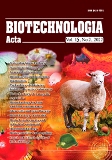ISSN 2410-7751 (Друкована версія)
ISSN2410-776X (Електронна версія)

Biotechnologia Acta Т. 15, No. 2, 2022
P. 66-67, Bibliography 3, Engl.
UDC: 577.115+57.084+57.037+616-006+615.03
https://doi.org/10.15407/biotech15.02.066
K. S. Romanenko, T. M. Horid’ko
Palladin Institute of Biochemistry of the National Academy of Sciences of Ukraine, Kyiv
Aim. To study the possible protective effect of cannabimimetic lipid - N-stearoylethanolamine (NSE) on the lipid composition of the frontal cortex, hippocampus and on the state of episodic memory of old rats.
Methods. Extraction of lipids from the tissues of the hippocampus and frontal cortex of rats was performed by the method of Bligh and Dyer. Phospholipids were separated by two-dimensional thin layer chromatography. Methyl esters of fatty acids from lipid extract were obtained by a modified method of Carreau and Dubaco. Quantitative analysis of fatty acid methyl esters was performed by gas-liquid chromatography on an Agilent GC7890 chromatograph with an Agilent 8987 mass detector. The fractions of free and esterified cholesterol were separated by one-dimensional thin layer chromatography. The dry cholesterol residue was analyzed on a Carlo Erba gas-liquid chromatograph.
Results. The study of the diacyl (DF) and plasmalogen (PF) forms of phospholipids (PLs) content in the frontal cortex and hippocampus have shown a significant decrease in the plasmalogen form of PE (Phosphatidylethanolamine) (up to 15%) and an increase in its DF, compare to its content in young rats. Administration of NSE to old rats led to a significant increase in PF PE and did not cause significant changes in the content of PF in the composition of other PL of the frontal cortex of the brain and hippocampus.
The decrease in the percentage of various phospholipids was found in frontal cortex and hippocampus of old rats: the content of phosphatidylcholine (PC) and phosphatidylinositol (PI) was significantly reduced in the frontal cortex and the decrease of diphosphatidylglycerol (DPG), PI and phosphatidylserine (PS) was found in the hippocampus, compare to the young animals.
Administration of NSE to old rats had a different effects on the content of various phospholipids. The increase in the content of PC and PI in the frontal cortex and PS and DPG in the hippocampus is particularly pronounced due to NSE.
An increase in the content of saturated fatty acids (FFAs ) and a decrease in the content of unsaturated FFAs in the frontal cortex and hippocampus of old rats also has been found.
It has also been found that NSE administration to old rats promoted the growth of the free cholesterol level in the frontal cortex and hippocampus.
The results of the New Object Recognition test in old rats have shown that a short-term memory has been improved by NSE.
Conclusions. The administration of NSE to old rats causes an increase in PF of PLs in the frontal cortex and hippocampus of the brain, which can be considered as one of the mechanisms of neuroprotective action of NSE in aging. The changes in the phospholipids and fatty acids composition, and free cholesterol level of the frontal cortex and hippocampus of the brain of old rats caused by NSE administration have been shown to be adaptive and restorative. The New Object Recognition Behavioral Test has shown that NSE restores short-term memory in older rats.
The obtained results expand the understanding of the mechanisms of biological action of NSE during aging in mammals and create the basis for the development a new drug with geroprotective properties.
Key words. N-stearoylethanolamine, aging, phospholipids, plasmalogens, fatty acids, cholesterol, memory.
© Palladin Institute of Biochemistry of the National Academy of Sciences of Ukraine, 2022
References
1. Stepanova M., Rodriguez E., Birerdinc A., Baranova A. Age-independent rise of inflammatory scores may contribute to accelerated aging in multi-morbidity. Oncotarget. 2015, 6, 1414?1421. https://doi.org/10.18632/oncotarget.2725
2. de Diego I., Peleg S., Fuchs B. The role of lipids in aging-related metabolic changes. Chemistry and Physics of Lipids. 2019, V. 222, P. 59?69. https://doi.org/10.1016/j.chemphyslip.2019.05.005
3. Naud? A., Cabr? R., Jov? M., Ayala V., Gonzalo H., Portero-Ot?n M., Ferrer I., Pamplona R. Lipidomics of human brain aging and Alzheimer's disease pathology. International Review of Neurobiology. 2015, V. 122, P. 133?189. https://doi.org/10.1016/bs.irn.2015.05.008

